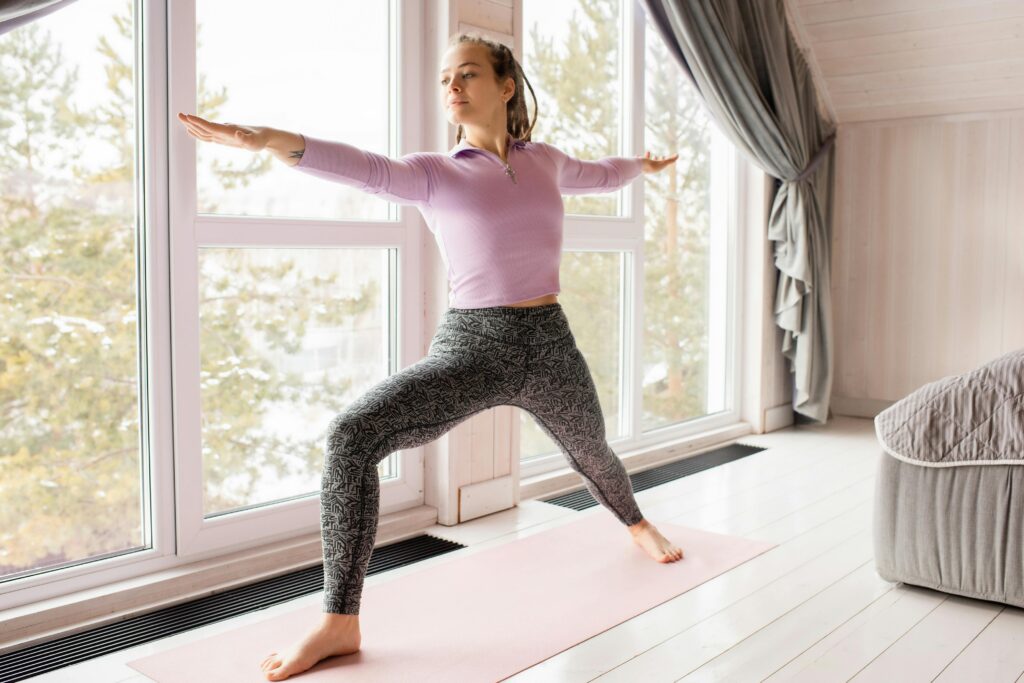
No gym? No problem! Here’s the trick to stay fit from your home.
Table of Content
- Introduction
- Advantages of Home Workout
- Warm-Up Routine Before Home Workout
- 10 Best Home Workout Exercises Without Equipment
- Jumping Jacks
- Bodyweight Squats
- Push-Ups
- Lunges
- Plank
- Mountain Climbers
- Glute Bridges
- Triceps Dips (Using Chair or Bed)
- High Knees
- Wall Sit
- Home Workout Plan for Beginners
- Full Body Workout at Home: Sample Routine
- The Most Typical Errors to Avoid
- Motivatioin Tips
- Home Workout FAQs
- Conclusion
Introduction
Getting fit doesn’t mean you have to pay for a fancy gym or some pricey equipment. With a little motivation and your body weight, you can begin a transformative fitness journey in the comfort of your home. This guide will take you through the most effective home workout without equipment so you can burn calories, gain strength, and feel amazing.All you need is a little bit of motivation, some space, and your body weight, and you can get an intense, full-body home workout equipment. Whether you’re a beginner or wish to vary your typical fitness routine, the following 10 efficient home workout exercises can be done at home without equipment.
Advantages of Home Workout
- No need for equipment
Bodyweight exercises—such as squats, push-ups, and planks, as well as lunges and planks—are versatile and effective. They can help build strength, muscle, and cardiovascular endurance without any equipment.
Save time & money.
Missing the gym fee and drive saves money and creates time—making it simpler to adhere to exercise.
Flexible & convenient
You can do it at any moment, in any area—morning, afternoon, or evening—making it simple to fit into your schedule .
- Privacy & comfort
Exercising at home gives you a criticism-free zone where you can concentrate and feel at ease.
- Adaptable for all fitness levels
Exercises can be made easier or tougher—beginners to athletes can modify reps, tempo, variations, and resistance.
- Excellent for functional fitness
Bodyweight and functional exercises replicate daily movements (such as standing up from a chair or ascending stairs), enhancing real-life strength and flexibility.
- Health and wellness benefits
Home training regularly enhances mood, lessens stress, increases energy—and even safeguards bones, metabolism, and brain health
.
Warm-Up Routine Before Home Workout
Warming up prepares your muscles, avoids injury, and enhances performance. A 5-minute warm-up can consist of:
Arm Circles (30 sec)
- Stand with your feet shoulder-width apart.
- Hold arms out to the sides at shoulder height.
- Make tiny circles with them, increasing in size.
- 15 sec forward, then 15 sec backward.
- This warms up shoulder joints and upper back.
High Knees (1 min)
- Stand with your arms bent at 90°.
- Jog in place, pushing your knees up towards your chest.
- Pump your arms briskly, marching quickly.
- Excellent for increasing heart rate and heating up hip flexors.
Hip Rotations (30 sec)
- Feet shoulder-width apart, hands on hips.
- Move hips in a circle.
- Begin small, gradually expand range.
- 15 sec clockwise and 15 sec anticlockwise.
- Loosens hips, warms lower back and glutes.
Jumping Jacks (1 min)
- Stand with feet together, hands at side.
- Jump legs out, bring arms up over head; return to beginning.
- Land gently, knees slightly bent to minimize joint impact.
- Efficient cardio exercise that also involves shoulders and legs.
Neck Rolls (30 sec)
- Stand or sit with a straight spine.
- Roll your neck to the right shoulder → down → left → back → and come back.
- 5 rotations per side, repeat once.
- Relaxes tension in the neck and loosens the shoulders.
10 Best Home Workout Exercises Without Equipment
Jumping Jacks
Target: Full Body
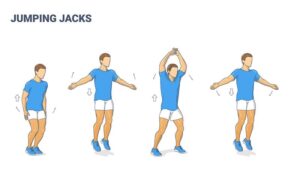
Excellent for full-body activation and cardio. Reps: 30 seconds x 3 rounds.
Jumping jacks is a great cardio warm-up that gets the circulation going and prepares your body. This classic exercise builds heart strength, improves endurance, and improves coordination.
How to do it:
- Feet together, hands by sides.
- Jump with legs wide apart and arms up.
- Jump back to position and repeat it all again.
Bodyweight Squats
Target: Legs, Glutes, Core.
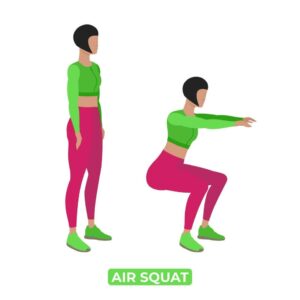
Targets glutes, quads, and hamstrings. Reps: 15 reps x 3 sets.
Squats with your body weight make your lower body stronger and develop balance.
How to do it:
- Stand shoulder-width apart.
- Lower your body as if sitting in a chair, your knees behind your toes.
- Maintain a straight back and chest.
- Push back up to the initial position
Push-Ups
Target: Chest, Shoulders, Triceps, Core
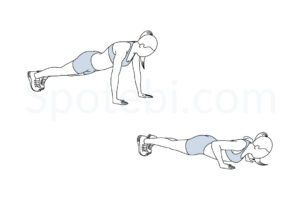
Perfect for chest, shoulders, and triceps. Reps: 10-12 reps x 3 sets.
Push-ups are a fundamental strength movement that involves the upper body and core.
Instructions:
- Place hands shoulder-width apart on ground, legs straight.
- Lower chest until it is nearly on ground.
- Push back to the starting position.
- Modify as needed by doing on your knees.
Lunges
Target: Legs, Glutes, Core
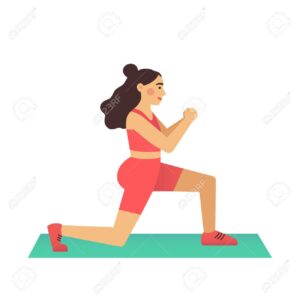
Strengthens leg and balance. Reps: 10 each leg x 3 sets.
Lunges work your quads, hamstrings, and glutes, and also strengthen your balance.
How to do:
- Step out with one of your legs.
- Squat down so that both knees are bent to 90 degrees.
- Push back to the starting position and repeat with the other leg.
Plank
Target: Core
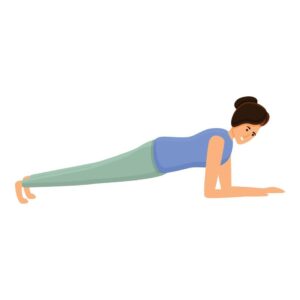
Strengthens core and stabilizes posture. Duration: 30-60 seconds x 3 rounds.
The plank works your entire core and improves posture and stability.
Instructions:
- Step into a plank position with your forearms.
- Keep your body in a head-to-toe straight line.
- Engage your core and hold.
Mountain Climbers
Target: Cardio, Core
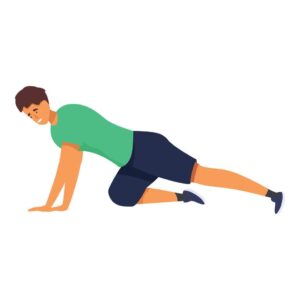
Increases cardio and core activation. Reps: 30 secs x 3 rounds.
Challenging cardio exercise that also hits your abs.
How to do it:
- Get into a push-up position.
- Bring in one knee, then quickly switch legs.
- Tuck your core in and move quickly for best effect.
Glute Bridges
Target: Glutes, Lower Back
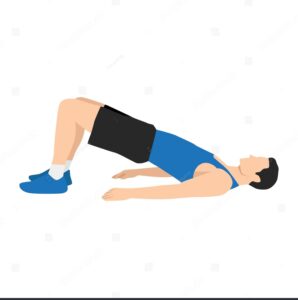
Excellent for glutes and lower back. Reps: 15 reps x 3 sets.
Perfect for developing hips and behind.
How to do it:
- Lie flat on your back, knees bent, feet firm on the floor.
- Lift your hips so that your body forms a straight line.
- Squeeze glutes at the top, then lower.
Triceps Dips (Using Chair or Bed)
Target: Arms (Triceps)
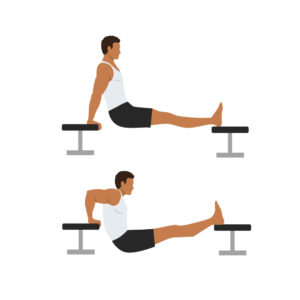
Tones arms and back. Reps: 10-12 reps x 3 sets.
A great exercise to tone your arms is by using a simple chair.
How to:
- Sit on the edge of a chair with hands on the hips.
- Slide down from the edge and lower your body by bending elbows.
- Push back up without locking elbows
High Knees
Target: Cardio, Legs, Core
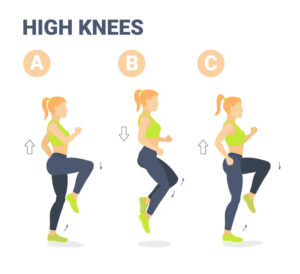
Great for short cardio bursts. Reps: 30 secs x 3 rounds.
High knees increase your heart rate and burn calories rapidly.
How to do it:
- Run in place while lifting your knees as high as possible.
- Pump your arms for extra burn.
Wall Sit
Target: Thighs, Core
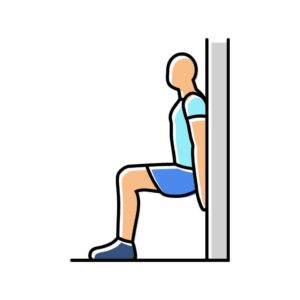
Builds endurance in legs. Duration: 30-45 seconds x 3 rounds.
Feel the burn with this isometric lower-body strength builder.
How to do it:
- Lean against a wall and slide down until your thighs are parallel to the floor.
- Hold that position, keeping your back flat and knees at 90 degrees.
Home Workout Plan for Beginners
Day | Focus Area | Workout sets |
| 1 | Full body | Jumping jacks, Push-Ups, Squats, Plank |
| 2 | Lower body | Squats, Lunges, Glute Bridges, Wall Sit |
| 3 | Rest or Light Stretching | Walk, Yoga |
| 4 | Upper Body & Core | Push-Ups, Triceps Dips, Plank, Mountain Climbers |
| 5 | Cardio + Strength | High Knees, Jumping Jacks, Lunges, Push-Ups |
| 6 | Full Body Circuit | Combine all 10 workouts |
| 7 | Rest or Recovery | Light Stretching, Breathing Exercises |
Full Body Workout at Home: Sample Routine
Do the following circuit 3 times:
- 20 Jumping Jacks
- 15 Squats
- 12 Push-Ups
- 10 Lunges per leg
- 30-sec Plank
- 30-sec High Knees
- 15 Glute Bridges
The Most Typical Errors to Avoid
Ignoring Warm-Up and Cool-Down
Why it’s important: While cooling down aids in a gradual drop in heart rate and promotes recovery, warming up improves blood circulation, primes muscles and joints, and reduces the risk of injury.
Bad Form
Why it matters: Poor form, such as locking your joints or arching your spine, decreases efficiency and increases the chance of injury.
Fix: Use smaller weights, stay in alignment, and follow instructions from videos or trainers.
3.Overtraining and lack of rest
Rest Problem: Overtraining frequency and intensity without rest leads to fatigue, burnout, plateaus, and a heightened risk for injury.
The solution is to add rest days, modify the intensity level, and have adequate sleep and food.
Not Having a Balanced Schedule
Problem: Excessive focus on strength or cardio leads to performance and general fitness imbalances.
Solution: Combine strength, cardio, and flexibility training—do not neglect mobility training.
Not Having a Plan
Problem: Alternating workouts without routine makes it hard to track progress and leading to uneven results
Solution: Set clear goals, track your workouts, and have regular routine schedules (e.g., ≥3 sessions/week).
Motivation Tips
Warm up before exercising: 5–10 minutes of gentle cardio (jogging in place, arm circles).
Cool down stretching to relieve soreness.
Hydrate while exercising.
Consistency is the key: 3–5 days a week.
Motivate with music. Play high-energy workout playlists or mixes.
Home Workout FAQs
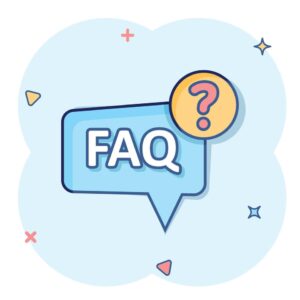
Q1: Is the home workout comparable to the gym?
Yes, especially for weight loss, toning, and cardio fitness.
Q2: How long should I do the home workout?
20 to 45 minutes depending on your fitness level.
Q3: Can I lose weight with a home workout?
Yes, in combination with a good diet and consistency.
Q4: How often should I do this?
Shoot 4 to 6 days with at least 1 day rest.
Q5: Do I need supplements?
Not really, but protein will help you recover
Q6: Should I warm up and cool down?
Yes! A 5-minute warm-up (light stretching, jogging in place, or arm circles) gets your body ready and avoids injury. Cool down with static stretches after exercise to increase flexibility and decrease soreness.
Q7: Is it advisable to use a yoga mat or equipment?
While not necessary, a yoga or exercise mat will make the routine easier, especially for floor work, like glute bridges or planks. Loose clothing and comfortable attire are also helpful.
Q8: A few suggestions to encourage me to exercise at home?
- Establish a series of small, achievable fitness goals.
- Use fitness apps or timers.
- Establish a routine.
- Play your favorite exercise music.
- Track your progress weekly.
Conclusion
A regular home workout without equipment can change your body, mind, and energy levels. As a beginner or coming back to fitness, these exercises are safe, effective, and liberating.

